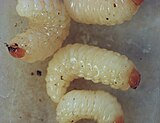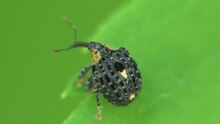Curculionidae
| True weevils and bark beetles | |
|---|---|

| |
| Scientific classification | |
| Kingdom: | Animalia |
| Phylum: | Arthropoda |
| Class: | Insecta |
| Order: | Coleoptera |
| Infraorder: | Cucujiformia |
| Clade: | Phytophaga |
| Superfamily: | Curculionoidea |
| Family: | Curculionidae Latreille, 1802 |
| Diversity | |
| Some 20 subfamilies (see text) | |

The Curculionidae are the family of the "true" weevils (or "snout beetles"). They are one of the largest animal families, with 6,800 genera and 83,000[1] species described worldwide. They are the sister group to the subfamily Brentidae[2]
They include the bark beetles as the subfamily Scolytinae, which are modified[unreliable source?] in shape in accordance with their wood-boring lifestyle. They do not much resemble other weevils, so they were traditionally considered a distinct family, Scolytidae. The family also includes the ambrosia beetles, of which the present-day subfamily Platypodinae was formerly considered the distinct family Platypodidae.
Description[]
They are recognized by their distinctive long snouts and geniculate antennae with small clubs; beyond that, curculionids have considerable diversity of form and size, with adult lengths ranging from 1 to 40 mm (0.04 to 1.57 in).

Weevils are almost entirely plant feeders, and most species are associated with a narrow range of hosts, in many cases only living on a single species. With so many species to classify and over 400 genera, the taxonomy of this family is quite complicated, and authors disagree on the number and placement of various subfamilies, tribes, and subtribes.
Although pesticide resistance hasn't historically been an issue with these insects, recently a mutation was discovered in association with the voltage-gated sodium channel in the species Sitophilus zeamais, indicating there is a lot to learn about how these insects adapt to changing environments.[3]
Behavior[]
Many species of Weevils are common household and garden pests, but don't harm people, pets, or buildings. Their presence is more of a temporary nuisance. In tropical areas they have larger effects, specifically several species in the genera Conotrachelus and Copturus.[4] Recently, another species, Cylas formicarius has been observed with an increased amount of inbreeding suppression than is normal for the average population of weevils, both intraspecific and interspecific.[5]
Phylogeny and systematics[]
The phylogeny of the group is complex; with so many species, a spirited debate exists about the relationships between subfamilies and genera. A 1997 analysis attempted to construct a phylogeny based mainly on larval characteristics.[6]
Recent work on the phylogenetic relationships in weevils mentions the two subfamily groups Adelognatha (short-nosed weevils, subfamily Entiminae) and Phanerognatha (long-nosed weevils, subfamilies of Curculionidae other than Entiminae) for the species of Curculionidae.[7]
Almost two dozen subfamilies are recognized by some authors even when merging those that are certainly invalid. Others, however, recognize a lesser number – the only subfamilies that are almost universally considered valid are the Baridinae, Cossoninae, Curculioninae, Cyclominae, Entiminae, Molytinae, Platypodinae, and Scolytinae. The various proposed taxonomic schemes typically recognize as many additional subfamilies again, but little agreement is seen between authorities about which. In particular, the delimitation of the Molytinae has proven difficult.
The timeline for current and extant weevil speciation and diversification is consistent with the radiation of gymnosperms during the Mesozoic period.[8]

The subfamilies considered valid by at least some authors today:
- Bagoinae (sometimes in Molytinae)
- Baridinae
- Brachycerinae (disputed)
- Conoderinae (sometimes in Baridinae)
- Cossoninae
- Cryptorhynchinae (sometimes in Curculioninae)Cionus tuberculosus (Curculioninae)
- Curculioninae – flower weevils, acorn and nut weevils
- Cyclominae
- Dryophthorinae (sometimes placed at family level)
- Entiminae – broad-nosed weevils
- Etheridgea (disputed)
- Hyperinae (sometimes in Molytinae)
- Lixinae (sometimes in Molytinae)
- Mesoptiliinae (sometimes in Molytinae)
- Molytinae
- (sometimes in Baridinae)
- Platypodinae – typical ambrosia beetles, "higher" Curculionidaes[9]
- Raymondionyminae (sometimes in Brachycerinae)
- Scolytinae – bark beetles
- (sometimes in Baridinae)
See also[]
- Black vine weevil
- Boll weevil
- Pecan weevil
- Wheat weevil
- Hylobius
- Premnotrypes
- Scolytoplatypus
- Pests and diseases of roses
References[]
- ^ "Curculionidae". www.gbif.org.
- ^ Gunter, N. L., Oberprieler, R. G., and Cameron, S. L. (2016) Molecular phylogenetics of Australian weevils (Coleoptera: Curculionoidea): exploring relationships in a hyperdiverse lineage through comparison of independent analyses. Austral Entomology, 55: 217– 233. doi: 10.1111/aen.12173.
- ^ Araújo, R.A., Williamson, M.S., Bass, C., Field, L.M. and Duce, I.R. (2011), Pyrethroid resistance in Sitophilus zeamais is associated with a mutation (T929I) in the voltage‐gated sodium channel. Insect Molecular Biology, 20: 437-445. https://doi.org/10.1111/j.1365-2583.2011.01079.x
- ^ Hernandez L, Castañeda A, Urias-Lopez M, Fuentes LMH, Vildozola AC, Urías-López MA (2017) Weevil borers in tropical fruit crops: importance, biology and management. In: Shields Vonnie.D.C, E. (ed.), Insect Physiol Ecol. IntechOpen, Rijeka, pp 43
- ^ Kuriwada, T., Kumano, N., Shiromoto, K. et al. Inbreeding avoidance or tolerance? Comparison of mating behavior between mass-reared and wild strains of the sweet potato weevil. Behav Ecol Sociobiol 65, 1483–1489 (2011). https://doi-org/10.1007/s00265-011-1158-6
- ^ Adriana E. Marvaldi (1997). "Higher level phylogeny of Curculionidae (Coleoptera: Curculionoidea) based mainly on larval characters, with special reference to broad-nosed weevils" (PDF). Cladistics. 13 (4): 285–312. doi:10.1111/j.1096-0031.1997.tb00321.x. S2CID 202843753. Archived from the original (PDF) on 2012-02-18. Retrieved 2009-12-12.
- ^ François Lieutier, Keith R. Day, Andrea Battisti, Jean-Claude Grégoire, and Hugh F. Evans, Bark and Wood Boring Insects in Living Trees in Europe, a Synthesis. Springer Science & Business Media, 2004
- ^ Seunggwan Shin, Dave J Clarke, Alan R Lemmon, Emily Moriarty Lemmon, Alexander L Aitken, Stephanie Haddad, Brian D Farrell, Adriana E Marvaldi, Rolf G Oberprieler, Duane D McKenna, Phylogenomic Data Yield New and Robust Insights into the Phylogeny and Evolution of Weevils, Molecular Biology and Evolution, Volume 35, Issue 4, April 2018, Pages 823–836, https://doi-org/10.1093/molbev/msx324
- ^ Gunter, N. L., Oberprieler, R. G., and Cameron, S. L. (2016) Molecular phylogenetics of Australian weevils (Coleoptera: Curculionoidea): exploring relationships in a hyperdiverse lineage through comparison of independent analyses. Austral Entomology, 55: 217– 233. doi: 10.1111/aen.12173.
External links[]
 Media related to Curculionidae at Wikimedia Commons
Media related to Curculionidae at Wikimedia Commons Data related to Curculionidae at Wikispecies
Data related to Curculionidae at Wikispecies- Images of Curculionidae species found in New Zealand
On the University of Florida / Institute of Food and Agricultural Sciences Featured Creatures website:
- Anthonomus eugenii, pepper weevil
- Cylas formicarius, sweetpotato weevil
- Chalcodermus aeneus, cowpea curculio
- Cosmopolites sordidus, banana root borer
- Eudociminus mannerheimii, cypress weevil
- Eurhinus magnificus
- Gerstaeckeria spp.
- Metamasius callizona, Mexican bromeliad weevil
- Metamasius hemipterus sericeus, silky cane weevil,
- Metamasius mosieri, Florida bromeliad weevil
- Naupactus (=Graphognathus) spp., whitefringed beetles
- Oxyops vitiosa, melaleuca weevil
- Pantomorus cervinus, Fuller rose weevil
- Pseudocneorhinus bifasciatus, twobanded Japanese weevil
- Rhynchophorus cruentatus, palmetto weevil
- Sphenophorus venatus, hunting billbug
Other university web pages on economically important curculids:
- Conotrachelus nenuphar, plum curculio from the Ohio State University
- Orchestes pallicornis, apple flea weevil from Michigan State University
- Curculionidae
- Insect vectors of plant pathogens
- Beetle families
